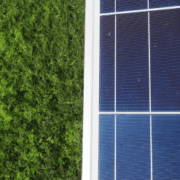Save Green by “Going Green”
If you are considering funding improvements that will enhance the energy efficiency of your home, you may be able to save money on your upcoming projects under the Inflation Reduction Act (IRA). The IRA was signed into law in 2022, and the bill’s main goal is to combat climate change by enticing businesses to adopt environmentally friendly protocols and promote the use of clean energy across America. Also included in the IRA are tax credits for individuals who modernize their homes by implementing “green” updates. The IRA extends and amends two tax credits—The Energy Efficient Home Improvement Credit and The Residential Clean Energy Credit.
The Energy Efficient Home Improvement Credit
The Energy Efficient Home Improvement credit was set to expire in 2021 but was revitalized by the IRA. Prior to 2023, the credit had a lifetime limit of $500, meaning amounts taken in prior years counted towards a taxpayer’s credit limit. The new credit is now worth 30% (up from 10%) of the costs paid for qualified energy improvements, and the lifetime limit has been replaced with a $1,200 annual limit (or $2,000 per year for appliances like heat pumps and water heaters). This means you can invest in your home over time and potentially receive a tax credit for qualified improvements each year, or as your budget allows.
To qualify, home improvements must be new, not previously completed, and meet stringent energy efficiency standards, such as the Energy Star rating. Qualified eco-friendly upgrades include new exterior doors, windows and skylights, insulation materials and home appliances that improve heating and cooling efficiency. The credit is allowed for qualified property placed in service through 2032.
It is important to note that labor costs for installing some of the items listed above do not qualify for the credit. Homeowners should ask their contractors for an itemized statement that differentiates the cost of materials from the cost of labor and consult with their tax advisor. The home improvement credit is nonrefundable, meaning taxpayers can utilize the credit to reduce their tax bill to zero, but the excess credit amount will not generate a refund. Taxpayers are not able to carry the credit forward to reduce their tax bill in the future and should consider this when budgeting and planning for home upgrades.
The Residential Clean Energy Credit
If you’re looking to make a drastic change to your home by installing solar panels or systems that use wind or geothermal power to produce energy, you should be eyeing the Residential Clean Energy Credit. This credit was set to expire in in 2024 but has now been extended through 2034. The IRA increased the credit amount from 26% of the cost to install qualified property to 30%. Unlike the home improvement credit, the clean energy credit includes labor as a qualifying expense and allows taxpayers to carry forward unused credit amounts to offset their tax owed in future years.
Recently, I had a client install solar panels on their primary residence, and the total system price was roughly $42,000. This purchase occurred before 2023, so they received a tax credit equal to 26% of the purchase price, or $10,920. They were then able to offset their tax liability dollar-for-dollar by this amount.
My clients were excited to save green by “going green.” As you can see from my example above, investing in sustainable improvements for your home can be costly. That’s why you should consult your tax advisor to help you navigate the various energy incentives that are available to you to maximize your tax saving opportunities.
Published in the Victoria Advocate
Carlee H. Gibbs, CPA is a staff accountant for Keller & Associates CPAs, PLLC.



